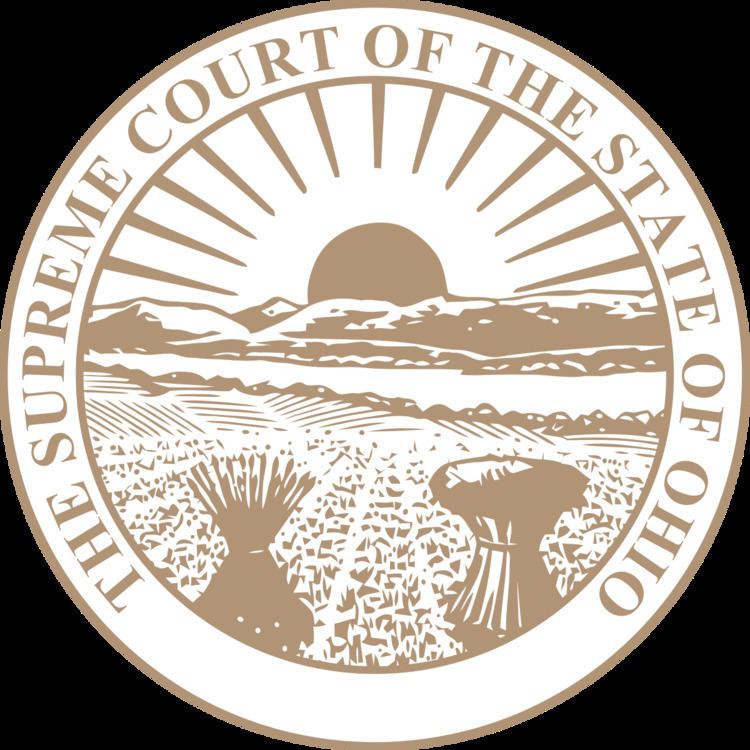Composition method Semipartisan election Judge term length 6 Years Phone +1 614-387-9000 Established 1841 | Authorized by No. of positions 7 Number of positions 7 | |
 | ||
Address 65 S Front St, Columbus, OH 43215, USA Hours Closed today SaturdayClosedSundayClosedMonday8AM–5PMTuesday8AM–5PMWednesday8AM–5PMThursday8AM–5PMFriday8AM–5PMSuggest an edit Decisions are appealed to | ||
The Supreme Court of Ohio is the highest court in the U.S. state of Ohio, with final authority over interpretations of Ohio law and the Ohio Constitution. The court has seven members, a chief justice and six associate justices, each serving six-year terms. Since 2004, the court has met in the Thomas J. Moyer Ohio Judicial Center (formerly known as the Ohio Departments Building) on the east bank of the Scioto River in downtown Columbus. Prior to 2004, the court met in the James A. Rhodes State Office Tower and earlier in the Judiciary Annex (now the Senate Building) of the Ohio Statehouse.
Contents
The Ohio Supreme Court and the rest of the judiciary is established and authorized within Article IV of the Ohio Constitution.
Justices
All the seats on the court are elected at large by the voters of Ohio. Every two years, two of the associate justice seats are up for election. For one of those three elections in a cycle, the chief justice's seat is up for election. In order to run for a seat on the court, a person must be admitted to the Bar in Ohio, and have practiced as a lawyer or served as a judge for at least six years. There is an age limit: One may not run for a seat on any Ohio court if one is more than 70 years of age. This limit often forces the retirement of long-time justices. Justice Francis E. Sweeney, Sr., was barred by this rule from running for re-election in 2004. However, a judge who reaches the age of 70 after being elected is not prevented from completing her or his term in office.
The Governor of Ohio may appoint a Justice to the Court when there is a vacancy.
Officially, the judicial elections are non-partisan. However, in practical terms, all this means is that party designations for the candidates are left off the ballot and justices are restricted in making public political statements. Major and minor parties all nominate candidates for the court in their primary elections. The vast majority of justices have been nominated by the two major parties in Ohio, Democratic or Republican. Many of the individuals who have contested Supreme Court seats have also contested for explicitly partisan political offices, both state and federal.
From the election of Justice Robert R. Cupp in November 2006 to replace Democrat Alice Robie Resnick until the 2010 appointment of Eric Brown as Chief Justice, the Court was all Republican.
Asterisks (*) next to retirement dates indicate justices who will be permitted to complete their current terms, but will be barred from running for reelection due to having exceeded the mandatory retirement age of 70 years.
Important cases
In DeRolph v. State (1997) the Supreme Court of Ohio found that Ohio's method of funding its schools was unconstitutional. The case originated in the Perry County Schools.
In Mapp v. Ohio (1961) the U.S. Supreme Court, reversed the Supreme Court of Ohio, and found that evidence seized unlawfully without a search warrant can't be used in criminal prosecutions.
In 2008, the Ohio Supreme Court went after an executor's camp in Maine, not within Ohio jurisdiction
Compensation
The data contained in the table comes from the website of the Buckeye Institute. Salaries are paid by the Ohio Treasurer.
Disciplinary Counsel
The Ohio Supreme Court Disciplinary Counsel investigate Ohio judges and attorneys in order to protect the public. The Ohio Supreme Court announced though its website the dismissal of former Disciplinary Counsel on 29 August 2013. Currently Scott Drexel is Disciplinary Counsel and his office investigates grievances.
